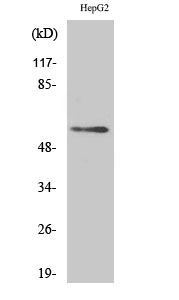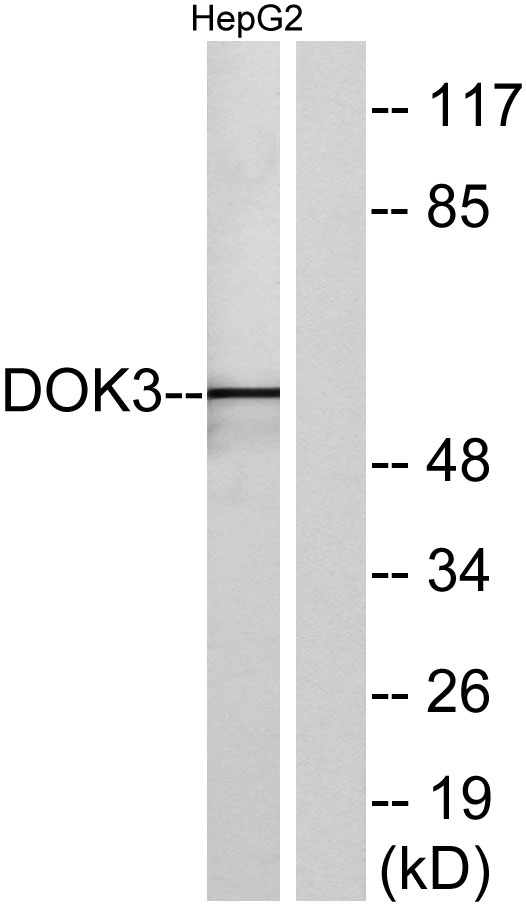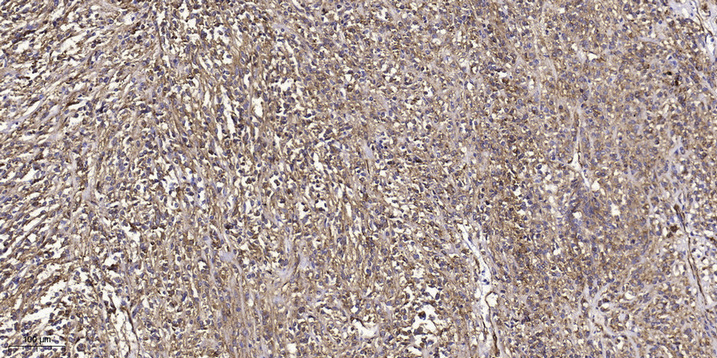Dok-3 Polyclonal Antibody
- Catalog No.:YT1397
- Applications:WB;IHC;IF;ELISA
- Reactivity:Human;Mouse
- Target:
- Dok-3
- Gene Name:
- DOK3
- Protein Name:
- Docking protein 3
- Human Gene Id:
- 79930
- Human Swiss Prot No:
- Q7L591
- Mouse Gene Id:
- 27261
- Mouse Swiss Prot No:
- Q9QZK7
- Immunogen:
- The antiserum was produced against synthesized peptide derived from human DOK3. AA range:101-150
- Specificity:
- Dok-3 Polyclonal Antibody detects endogenous levels of Dok-3 protein.
- Formulation:
- Liquid in PBS containing 50% glycerol, 0.5% BSA and 0.02% sodium azide.
- Source:
- Polyclonal, Rabbit,IgG
- Dilution:
- WB 1:500 - 1:2000. IHC 1:100 - 1:300. IF 1:200 - 1:1000. ELISA: 1:20000. Not yet tested in other applications.
- Purification:
- The antibody was affinity-purified from rabbit antiserum by affinity-chromatography using epitope-specific immunogen.
- Concentration:
- 1 mg/ml
- Storage Stability:
- -15°C to -25°C/1 year(Do not lower than -25°C)
- Other Name:
- DOK3;Docking protein 3;Downstream of tyrosine kinase 3
- Observed Band(KD):
- 58kD
- Background:
- domain:PTB domain mediates receptor interaction.,function:DOK proteins are enzymatically inert adaptor or scaffolding proteins. They provide a docking platform for the assembly of multimolecular signaling complexes. DOK3 is a negative regulator of JNK signaling in B-cells through interaction with INPP5D/SHIP1. May modulate ABL function.,PTM:Constitutively tyrosine-phosphorylated.,PTM:On IL2 stimulation, phosphorylated on C-terminal tyrosine residues possibly by Src kinases. Can also be phosphorylated by ABL kinase.,similarity:Belongs to the DOK family. Type A subfamily.,similarity:Contains 1 IRS-type PTB domain.,similarity:Contains 1 PH domain.,subunit:On tyrosine phosphorylation, interacts with CSK and INPP5D/SHIP1 via their SH2 domains. Both Tyr-381 and Tyr-398 are required for interaction with INPP5D. Only Tyr-381 is required for interaction with CSK. Binds ABL through the PTB domain and in a kinase-dependent manner. Does not interact with RasGAP.,tissue specificity:Expressed in spleen.,
- Function:
- domain:PTB domain mediates receptor interaction.,function:DOK proteins are enzymatically inert adaptor or scaffolding proteins. They provide a docking platform for the assembly of multimolecular signaling complexes. DOK3 is a negative regulator of JNK signaling in B-cells through interaction with INPP5D/SHIP1. May modulate ABL function.,PTM:Constitutively tyrosine-phosphorylated.,PTM:On IL2 stimulation, phosphorylated on C-terminal tyrosine residues possibly by Src kinases. Can also be phosphorylated by ABL kinase.,similarity:Belongs to the DOK family. Type A subfamily.,similarity:Contains 1 IRS-type PTB domain.,similarity:Contains 1 PH domain.,subunit:On tyrosine phosphorylation, interacts with CSK and INPP5D/SHIP1 via their SH2 domains. Both Tyr-381 and Tyr-398 are required for interaction with INPP5D. Only Tyr-381 is required for interaction with CSK. Binds ABL through the PTB domain
- Subcellular Location:
- Cytoplasm . Cell membrane ; Peripheral membrane protein ; Cytoplasmic side .
- Expression:
- Expressed in spleen.
- June 19-2018
- WESTERN IMMUNOBLOTTING PROTOCOL
- June 19-2018
- IMMUNOHISTOCHEMISTRY-PARAFFIN PROTOCOL
- June 19-2018
- IMMUNOFLUORESCENCE PROTOCOL
- September 08-2020
- FLOW-CYTOMEYRT-PROTOCOL
- May 20-2022
- Cell-Based ELISA│解您多样本WB检测之困扰
- July 13-2018
- CELL-BASED-ELISA-PROTOCOL-FOR-ACETYL-PROTEIN
- July 13-2018
- CELL-BASED-ELISA-PROTOCOL-FOR-PHOSPHO-PROTEIN
- July 13-2018
- Antibody-FAQs
- Products Images

- Western Blot analysis of various cells using Dok-3 Polyclonal Antibody

- Western blot analysis of lysates from HepG2 cells, using DOK3 Antibody. The lane on the right is blocked with the synthesized peptide.

- Western blot analysis of the lysates from K562 cells using DOK3 antibody.

- Immunohistochemical analysis of paraffin-embedded human small intestinal carcinoma tissue. 1,primary Antibody was diluted at 1:200(4° overnight). 2, Sodium citrate pH 6.0 was used for antigen retrieval(>98°C,20min). 3,Secondary antibody was diluted at 1:200



